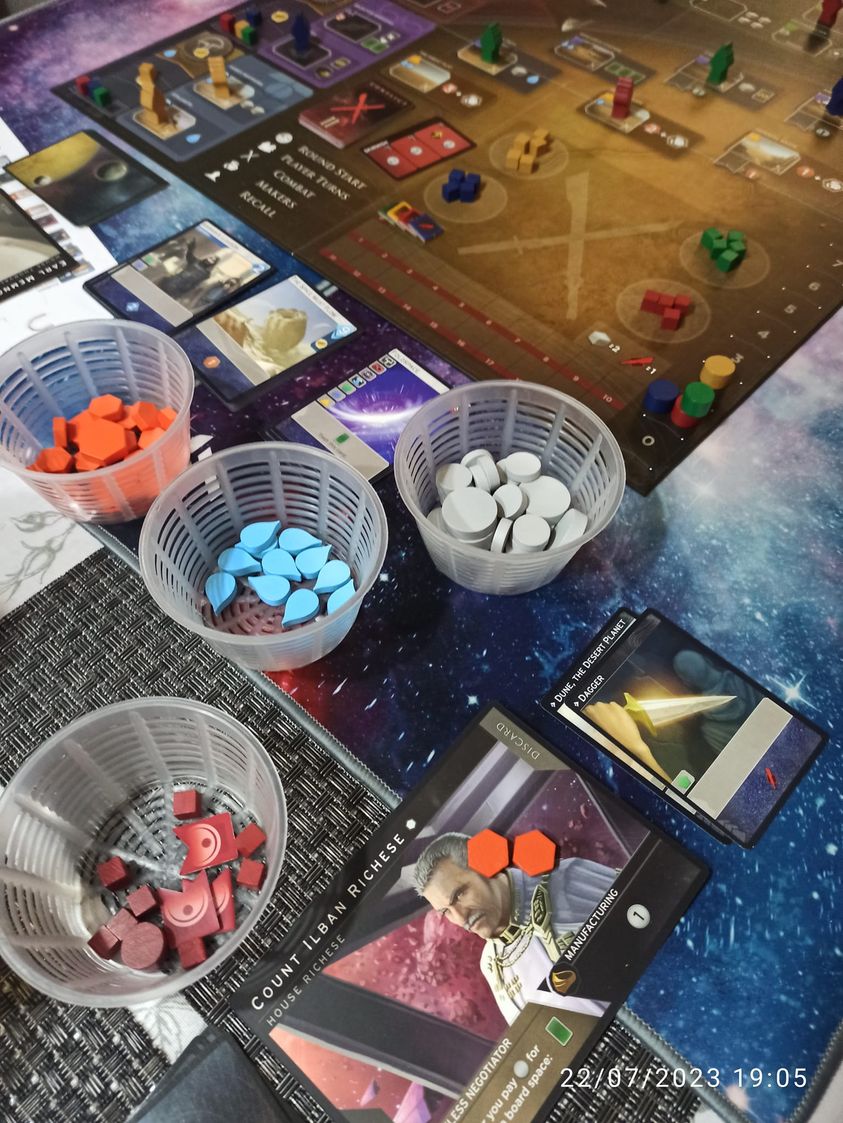Up until some years back, new
board game titles still had this aura of novelty about them, at least that was
my personal impression. There were still surprises to be had and the market was
jampacked with titles that made my eyes gleam whenever I saw them. Something was refreshing about the subject which appeared to capture the
imagination of hundreds of thousands, the world over.
Yet now as we approach the end of
the 3rd quarter of 2023, I am getting the feeling that the industry is not
quite as innovative as it was ten years ago. There is still talent out there,
and there are still some exciting titles coming up, but the frequency of them
feels less. We are getting “more of the same” as it were.
I am saying this, having seen
some recent video blogs that have made me think. The games that are coming out
are either a “plastic fest” of miniatures which, from personal experience, will
tend to remain bland, grey, and unpainted or behemoths that would need a
trolley to carry them around to your next gaming event. There’s also a third
category, the expansion packs, just too many of these in my opinion. I ask
myself, what’s wrong with the traditional, compact games, in standard-sized
boxes we grew up with? Or, better still, those games which used to pack hours
of fun in a manageable package? Also, I must add that this race for miniatures
and titan-sized packages often inflates retail prices substantially, to the
extent that only niche connoisseurs or board gamers with big pockets would dare
to invest in them.
There again, I am not stating
that there aren’t compact manageable titles out there, only that the industry
is offering way too much space to new heavyweights, as it were.
On a personal level, I realised
that perhaps it is us board gamers who are to blame for this situation. After
all, the market will always respond to the demands and expectations of the
clients who will fork out money to purchase a game. This situation then leads
to several effects as I will explain hereunder. However, for now, I will just
list them in bullet form.
- - Games will tend to use mechanisms that have proven to be popular.
- - Expansions to existing core games will be favoured over new products.
- - Games will copy established IPs to bank on their popularity.
- - Games will cater for miniature appetite over game substance.
- - Games will be crowdfunded often.
Games will tend to use
mechanisms that have proven to be popular.
It stands to reason that game
designers will try to build products based on mechanisms that have proven popular
or are currently the main fad. This could have interesting outcomes but at the
same time result in games that feel eerily similar if not identical. Two such
games that come to mind are Lost Cities of Arnak and Dune Imperium.
I opted to buy the latter, mostly because I happen to be a fan of Frank
Herbert’s books. Another pair of games that feel very similar as you sit down
to play them are Egizia-Shifting Sands and Imhotep-Builder of Egypt.
Both games are strongly themed with Egyptian iconography and art. Both have a
sort of queuing mechanism by which players select to visit specific sites to
earn points. There are points of difference, for instance, Egizia has a
gorgeous, fixed map with iconic ports, where players will place their workers
to activate actions and obtain points. Imhotep on the other hand uses large
cardboard stock cards to represent the locations, at which boats filled with
player resources dock to earn points. Both have a mix of in-game scoring as
well as final scoring...indeed these two could be considered cousins if not
siblings.
Expansions to existing core
games will be favoured over new products.
This is perhaps the most obvious
and in-your-face tactic adopted by game designers. Get an existing IP, perhaps a movie or some
other franchise which people know about and then design your game around that.
Once you establish the base game, then start churning out expansions. The list
here is quite substantial but I will just mention Disney Villainous which
can be considered as a perfect example of this strategy. So far, the original
Disney Villainous has six (6) expansions under its belt. Marvel Villainous
on the other hand, which can be considered a spin-off / re-skinning of sorts,
already has four (4) expansions. When you consider that the first Villainous
came out in 2018, that’s a lot of expansions for one title. It is also not the
only board game to get a slew of expansions. Another game, a deck builder,
called Ascension has had 15 expansions to date. The somewhat new title Dune
Imperium released in 2021 already has three expansions with the third expansion
being a standalone while also being an expansion. For the completionists
among us, these expansions can be a bane, an expensive one at that. Yet few
will find the space and time to play these expansions.
Games will copy established
IPs to bank on their popularity.
Going back to the game
“Villainous” and its Marvel variant, it is not surprising that this title is
going strong. Currently, the Marvel franchise is going from strength to strength
with Disney further leveraging its strengths through aggressive marketing, a
deep schedule of films and TV series and a presence in practically all relevant
mediums from comics to toys, to costumes and other paraphernalia. That this spilt
over into board games is not surprising at all. Others who may not have direct
access to the IP will still try to piggyback on the popularity of the hero
genre by creating games that contain hero types and scenarios deeply
reminiscent of the Marvel universe. I need to add however that this stratagem
is not specifically associated with board game design. Without going into the
merits of who came first or who did what, it is a known fact that Marvel and DC
comics created several characters based on the other's existing pantheon. So,
for instance, Marvel has Namor King of Atlantis and DC has Aquaman King of
Atlantis. DC had Dr. Fate and Marvel had Dr. Strange. The list goes on.
On a different note, and if we
were to expand the concept of IP to include IPs of established board game
franchises, we could mention the Pandemic brand of cooperative games as
a further example. There are as, of my last reckoning, 18 titles under this
brand, again a substantial list given that the first game came out in 2008.
However not to fault Z-man games, they have a substantial portfolio of
successful game titles other than just pandemic. I quote the pandemic series of
games, more as an example of exploiting a successful IP over time. Furthermore,
again to the merit of Z-man games, they did successfully create derivations of
the pandemic ruleset rather than just outright resorting to simple reskinning.
I like to mention here both Pandemic – Fall of Rome and Pandemic –
Rise of the Litch King which both offer familiar though distinct gaming
experiences.
Games will cater for miniature
appetite over game substance.
The use of miniatures in gaming
is nothing new. The first tabletop “war games” depended on a slew of miniature
soldiers, mounted cavalry, cannons and what have you, to breathe a certain
tangible (tactile?) quality into proceedings. Nowadays, while modern war gamers
seldom re-enact Napoleonic conflicts, they still utilise the same trappings of
the original games. You will still find painted miniature armies of infantry or
mounted troops as well as mock-ups of terrain and other obstacles to create
visual depth. As you would expect, some fans of these wargames are also avid
board gaming enthusiasts and therefore easily lured by the prospect of having
miniatures worked into a particular board game title. The same can be said of
D&D players, who might already be familiar with the use of miniatures in
their campaigns and therefore see these as important contributors towards the
appeal of a board game. Unsurprisingly, the number of games out there that rely
heavily on miniatures is breathtaking. The ever-popular “Zombicide” franchise
throws trays upon trays of miniatures into every box and expansion they churned
out. Games from CMON have developed a strong reputation for being
miniature-heavy titles. They obviously do not stand alone in this sense.
Personally, I must admit that
miniatures do add a little extra oomph to a game, but on the other hand, I
still feel that these are not enough to make a game brilliant. Good game
mechanisms and a solid ruleset will always triumph over top-notch gaming
pieces. As an example, I would like to offer a nod to the Undaunted
series of wargames which do not employ miniatures but which, on the other hand,
successfully employ cardboard tokens to great effect.
Yet for all their charm, these miniature-heavy
games are space hogs and more notably, very steeply-priced. A base or core game
could easily set you back €100 on the very lower end of the spectrum with some
titles going up to two hundred (200) or three hundred (300) Euro, or more, per
box. Add to this that most of these games are followed up with several
expansions and you can imagine the real investment that goes into owning and
playing these titles.
Games will copy established
IPs to bank on their popularity.
Here we can list games that copy
the looks of another popular board game just to get a leg into the market. For
instance, here I will mention Wingspan by Elizabeth Hargreaves published by
Stonemeier Games and Birdwatcher by Zakir Jafry published by Oni Games. While
the mechanisms used in either board game are noticeably different when you get
down to it, the first impression I got when I saw the box for Birdwatcher, was
that the latter was some kind of spinoff to the former title. It did not help
that Birdwatchers used a similar art style for their bird drawings as you find
in Wingspan. You may argue that a bird is a bird, so what could they have done differently?
In truth, they could have, for instance, chosen a more modern art style or
perhaps opted for minimalism to distinguish themselves from Wingspan. Better
still, they could have opted to focus on the birdwatching aspect as
inspiration for their box art, maybe focusing instead on birdwatching tools and
trappings rather than the birds themselves. In the end, they opted for artwork
that is strongly reminiscent of Wingspan. Ironically, while I have opted to
invest in Wingspan, I do not exclude purchasing a copy of Birdwatcher if I ever
get the opportunity.
Interestingly, my behaviour here leads
board game designers and publishers to stick to the tried and tested instead of
taking the path less travelled. Yet these same designers/publishers seem to
forget that the “original” is seldom dethroned by a contender, no matter how well-packaged
the latter might be. Nothing, in my opinion, can beat true originality.
Games will be crowdfunded
often.
In addition to what I have said
so far, there is another element in this equation that in my opinion could be
contributing towards the homogenisation of board game content. That factor is
crowdfunding. While the notion (i.e., crowdfunding) is indeed brilliant, and
gems are published from these ventures, the truth is that the crowdfunded games
are generally geared towards the connoisseurs, the board game collectors, or
consummate gamers. Basically, those board gamers, with deep pockets, willing to
spend a pretty penny to get their crowdfunded games.
Indeed, crowdfunded projects will
seldom in my opinion give rise to products one might consider “gateway games”.
To clarify, when I refer to
“gateway games”, I refer to those games which have been proven to be
particularly easy to teach, are appealing and are priced for casual players.
These are games that you will table confidently when inviting casual gamers to
a gaming event. Yet, I feel that it is precisely in what one would term
“gateway games” that you stand to find the real gems. Furthermore, precisely
“gateway” games stand a greater chance of attracting the next generation of
players and potential customers. You are not going to do that with something
like the gargantuan Gloomhaven, which though beautiful, is just way too niche
and specific, to appeal to the casual board game player out there.
The following is a personal thought exercise based on my industry perception. I feel that by focusing on niche markets and assuaging the needs of hardcore board gamers, crowdfunding could well end up crippling innovation and experimentation. The reason is obvious when you think about it, resources spent on managing crowdfunded, content-heavy board games, are effectively being re-routed from other potential ventures. In time as the number of hardcore aficionados will dwindle, there will be no newcomers into the arena, no new players to pick up the mantle. I predict that this will lead to a negative feedback cycle that will see the number of crowdfunded board game projects grow less. This will be followed by a period epitomised by a dearth of new titles and a resurgence in classic board games or reprints of older titles. What could happen after that is anybody’s guess.
And yet, while my impression is
that the seeds of the industry’s collapse have already been sowed and are,
perhaps inexplicably, being nurtured by a slew of bad decisions, market
pointers appear to be stating otherwise. An article in the Washington Post
stated that the global board game market currently has an estimated value
between $11 billion and $13 billion. The article goes on to say that it is
expected to grow by about 7 to 11 per cent over the next 5 years (Research
companies Technavio and Imarc). Yet on
the other hand, an article from Licensing International (https://licensinginternational.org/news/board-games-sales-slow-ahead-of-holidays/)
back in October last year appeared to be indicating a counter-argument whereby
booming demand for board games (spurred no doubt by the lockdowns during the
recent COVID pandemic) was showing the first signs of slowing down. Perhaps
here it must be read as slowing down to a new, perhaps lower level of
consumption now that people have effectively returned to more “normal” daily
routines. The same article also suggests that gamers are moving towards
purchasing titles they do not own, away from the classics they already own.
Linked to this, a survey site
PrintNinja noted that, in a survey they conducted, 41% of respondents claimed
to buy anything between 5 to 10 games a year. When you consider the associated
demographic and global context, that’s a lot of games per year. Year on year
cooperative games have picked up significant steam. The current trends in fact
show that these are precisely the type of games most sought after.
Yet what is most notable and ties
into the former argument linked to crowdfunding, PrintNinja notes that
independent developers have shaken up the market and gained traction for their
games through crowdfunding. This does not mean that making a game has been
simplified, there are challenges linked to sourcing, developing, and
distributing which they too must face. I would like to point out that it is not
uncommon for a crowdfunded game to never really see the light of day on account
of a failure in a key aspect of its development. Yet the eagerness of board
gamers to spend money on these games cannot be underestimated. It is the
motivation that leads these independent game designers to try their luck with publishing
board game titles. It’s in fact telling,
that 21% of respondents to a PrintNinja survey, indicated that they spend
anywhere between $600 to $1000 on board games per year. Equally telling that
41% stated that they purchase games through crowdfunding platforms.
Yet the future of board gaming
isn’t bleak, nor is this gaming genre’s demise anytime soon. The reason at the
end of the day is very simple. Mankind has played some sort of board game using
tokens, a board and some kind of ruleset, for eons. Board games have the power
to bring friends and family together over what mounts up to friendly, safe,
sandboxed competition. They can also serve as icebreakers when strangers meet
up, allowing everyone to connect over a shared activity that is at one time
engaging and entertaining. These attributes are not unique to boardgames
however as competitive sports have been used for similar purposes over time.
Yet board games can be considered more approachable on account that physical
prowess is not a necessary contributing factor as would be the case in sporting
activities.
This is precisely why I cannot
envisage board games ever going totally away. They will persist in some form or
other, reflecting the tastes as well as the social and cultural context in
which they evolve and thrive. Indeed, the very renaissance in this type of
gaming which has brought about the incredible boom we are still experiencing to
a degree, is what will guarantee that these plastic, wood, and cardboard
wonders will still be around when our great-grandchildren come of age.















